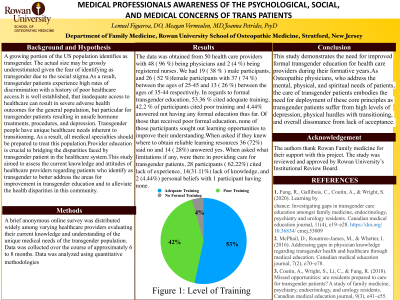Back

Medical Education
Medical Professionals Awareness of the Psychological, Social, and Medical Concerns of Trans Patients
Friday, March 31, 2023
12:00 PM East Coast USA Time

- LF
Lemuel Figueroa, DO
Doctor of Osteopathic Medicine
RowanSOM
Lindenwold, New Jersey, United States
Presenting Author(s)
Background and Hypothesis: A growing portion of the US population identifies as transgender.The actual size may be grossly underestimated given the fear of identifying as transgender due to the social stigma.As a result, transgender patients experience high rates of discrimination with a history of poor healthcare access.It is well established, that inadequate access to healthcare can result in severe adverse health outcomes for the general population, but particular for transgender patients resulting in unsafe hormone treatments, procedures, and depression. Transgender people have unique healthcare needs inherent to transitioning. As a result, all medical specialties should be prepared to treat this population.Provider education is crucial to bridging the disparities faced by transgender patient in the healthcare system.This study aimed to assess the current knowledge and attitudes of healthcare providers regarding patients who identify as transgender to better address the areas for improvement in transgender education and to alleviate the health disparities in this community.
Methods: A brief anonymous online survey was distributed widely among varying healthcare providers evaluating their current knowledge and understanding of the unique medical needs of the transgender population. Data was collected over the course of approximately 6 to 8 months. Data was analyzed using quantitative methodologies
Results: At baseline, data was obtained from 50 health care providers with 48 ( 96 %) being physicians and 2 (4 %) being registered nurses. We had 19 ( 38 % ) male participants, and 26 ( 52 %) female participants with 37 ( 74 %) between the ages of 25-45 and 13 ( 26 %) between the ages of 35-44 respectively. In regards to formal transgender education, 42.2 % of participants cited poor training and 4.44% answered not having any formal education thus far. Of those that received poor formal education, none of those participants sought out learning opportunities to improve their understanding.When asked if they knew where to obtain reliable learning resources 36 (72%) said no and 14 ( 28%) answered yes. When asked what limitations if any, were there in providing care for transgender patients, 28 participants ( 62.22%) cited lack of experience, 14 (31.11%) lack of knowledge, and 2 (4.44%) personal beliefs with 1 participant having none.
Conclusion: This study demonstrates the need for improved formal transgender education for health care providers during there formitive years. The importance of understanding where to obtain quality, reliable resources that are available to health care providers. Further studies could specifically assess medical students awareness of the medical needs of transgender patients with hopes of sparking there intellectual curiosity prior to patient exposure. As Osteopathic physicians, who address the mental, physical, and spiritual needs of patients, the care of transgender patients embodies the need for deployment of these core principles as transgender patients suffer from high levels of depression, physical hurdles with transitioning, and overall dissonance from lack of acceptance.
Acknowledgement of Research Study Sponsors and IRB: The authors thank Rowan Family medicine for their support with this project. The study was reviewed and approved by Rowan University’s Institutional Review Board.
Methods: A brief anonymous online survey was distributed widely among varying healthcare providers evaluating their current knowledge and understanding of the unique medical needs of the transgender population. Data was collected over the course of approximately 6 to 8 months. Data was analyzed using quantitative methodologies
Results: At baseline, data was obtained from 50 health care providers with 48 ( 96 %) being physicians and 2 (4 %) being registered nurses. We had 19 ( 38 % ) male participants, and 26 ( 52 %) female participants with 37 ( 74 %) between the ages of 25-45 and 13 ( 26 %) between the ages of 35-44 respectively. In regards to formal transgender education, 42.2 % of participants cited poor training and 4.44% answered not having any formal education thus far. Of those that received poor formal education, none of those participants sought out learning opportunities to improve their understanding.When asked if they knew where to obtain reliable learning resources 36 (72%) said no and 14 ( 28%) answered yes. When asked what limitations if any, were there in providing care for transgender patients, 28 participants ( 62.22%) cited lack of experience, 14 (31.11%) lack of knowledge, and 2 (4.44%) personal beliefs with 1 participant having none.
Conclusion: This study demonstrates the need for improved formal transgender education for health care providers during there formitive years. The importance of understanding where to obtain quality, reliable resources that are available to health care providers. Further studies could specifically assess medical students awareness of the medical needs of transgender patients with hopes of sparking there intellectual curiosity prior to patient exposure. As Osteopathic physicians, who address the mental, physical, and spiritual needs of patients, the care of transgender patients embodies the need for deployment of these core principles as transgender patients suffer from high levels of depression, physical hurdles with transitioning, and overall dissonance from lack of acceptance.
Acknowledgement of Research Study Sponsors and IRB: The authors thank Rowan Family medicine for their support with this project. The study was reviewed and approved by Rowan University’s Institutional Review Board.
